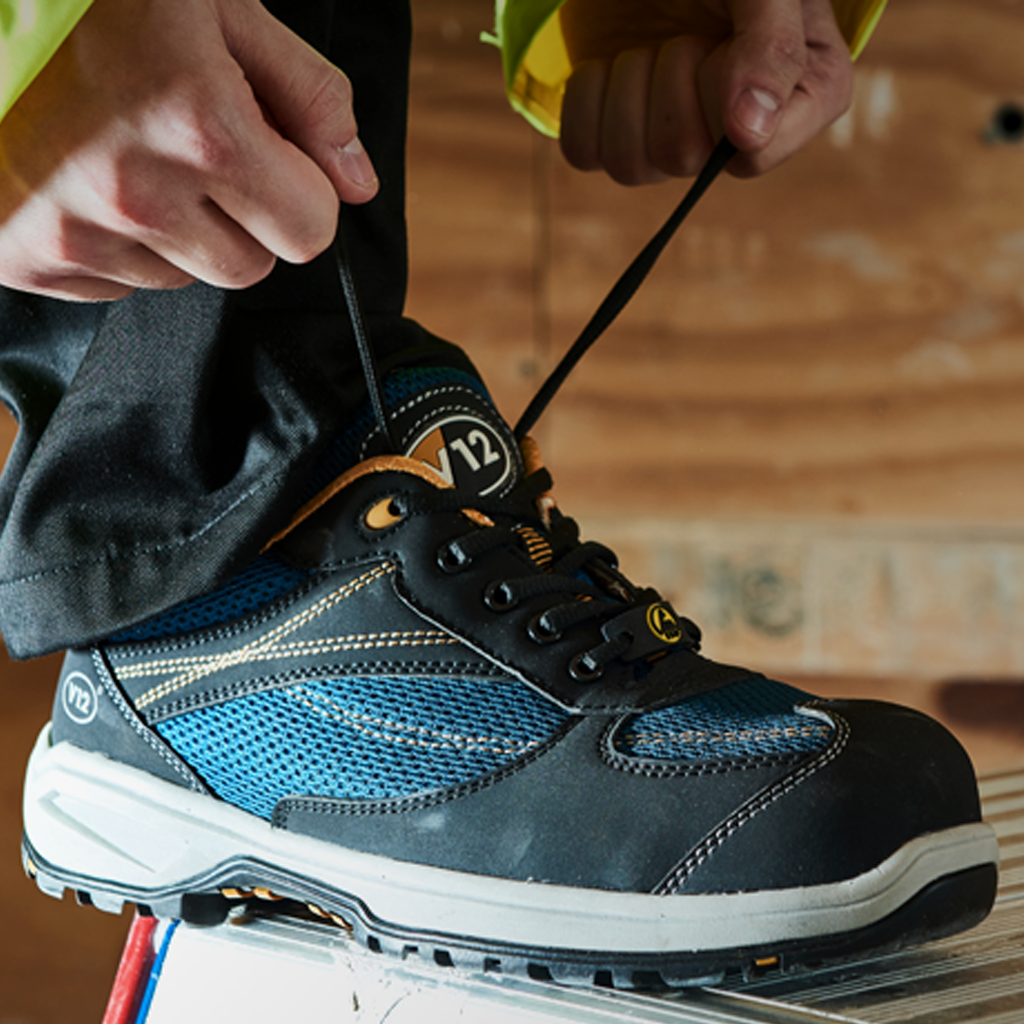You are teaching me how to put on a pair of safety boots?
That’s right… this article is teaching you the correct way to actually put on and wear a pair of safety footwear. It doesn’t seem like something which would require step by step instruction but it isn’t often as simple as breathing or riding a bicycle.
Because wearing safety footwear is subjective – you often have immediately negative views on wearing a product with a steel toe cap.
Subjective is a term that refers to someone’s personal opinions or feelings regarding particular subject matter. Subjective views or opinions are not based on truth or fact. They are one person’s unique interpretation of an idea and their thoughts and feelings.
So here are some tips to change negative connotations with regards to steel toe cap boots and shoes – and to stop your steel toe boots from hurting you, including finding the professional fit and how to actually wear them in a correct manner.
Steel toe cap boots are worn every single day in an industrial environment, up to 10 hours or more – so it is almost inevitable that you’ll experience some level of foot pain. The most common causes of foot pain in safety boots are blisters and rubbing, a tight or narrow feeling and then issues stemming from bunions, corns or even ingrown toenails.
Taking the time to try on a pair of safety boots, finding a suitable fit – and then breaking them in are vital in helping them being an asset to your feet and not a liability to your comfort.
How should they feel on my feet?
They should feel neither loose nor too tight. But they must feel snug and protective. Like swaddling a baby in a blanket. You should most certainly feel some resistance or pressure (you need to know they are there) but you shouldn’t feel any pain. Pain is not a snug feel. Pain is not resistance or pressure. Pain is a very sharp, unpleasant feeling that you would will know immediately. But snug is snug. And snug is important once the foot is inside the boot.
Don’t think you are only one size. Safety boots have a steel toe cap – and you should always try the size you think you are and one size up. Also, don’t try on only a left or only a right whilst siting down. Make 100% certain that you put on both shoes; left and right. As your feet are more often than not, actually different shapes and can be different sizes. Once they are on both feet, lace them up fully and tie them at the top. Stand up and walk around for a bit. This will immediately indicate pain. If they are simply snug. You are on the right track. If you detect any rubbing, or areas that may blister – you should look at a larger size. In a steel toe cap safety boot, your toes should not make contact with the front end of you footwear. On the flipside of that coin – you should not have too much space. We are looking for a snug fit. Not a foot moving around freely inside – as this leads to sliding along the footbed, which is essentially rubbing and can cause “the sandpaper effect” where your foot slides forward and backwards throughout the day. It will end in discomfort.
What should I wear when trying on my safety boots?
Point number one is to always remember to wear exactly the same type of industrial socks that you wear on a normal workday. Don’t come barefoot. Don’t come in running socks. Don’t come in super thick thermal socks. And don’t just wear a thin polyester sock. Wear the exact socks you wear at work. (Find the right type of sock to wear with our handy guide). Sounds silly – but remember, wearing thicker or thinner socks on the day will affect the fit. Guaranteed.
Your feet are always smallest the moment you get out of bed in the morning. And during a work day, in the first hours of standing on them, they begin to expand. After 7-10 hours on one’s feet they can be swollen due to long hours on one’s feet, less blood flow (lack of circulation) and we have actually seen feet 7% larger in the afternoon. For this reason – we always recommend trying on a shoe when they are at their largest… at the end of the day. It’s a great helpful hint.
What is breaking in a safety boot? And how can I do it?
The term “Breaking In” a pair of shoes originates as an analogy to the process of breaking in a horse. It takes some time – but is so worth it. It means helping them to conform to the shape of your feet, making them more comfortable to wear.
The Day You Get Them – Wear Them Around your House
The most common and easiest way to do this is, is for short periods of time at home. Starting daily, for ten minutes with increasing increments in the time wearing them. We have found, once you are in the snug fit – popping them on and taking a walk around the block helps tremendously. Especially in your industrial socks and on a nice warm day in the natural sunlight. By doing this, you will begin stretching the leather upper and improve the fit – from both outside on the upper in the sun and inside the boot with the natural temperature from your warm feet.
Should I Polish My Leather Boots?
Leather loves polish! Leather craves polish! Leather will absorb polish and soften! After a good polish – a nice walk in them again around the house or the block will help them soften and take the shape of your foot (mould to your feet quicker). If you do this daily – after you first purchase the boots, and then continue weekly… you will find a happier fit very quickly.
Always Lace Up
Again, often overlooked because of a lack of understanding about the importance of lacing. But, laces are there for a reason. Always lace those boots up to get a snug fit, and should they feel tight around the widest part of your foot, adjust the laces accordingly. This will give your foot a little more room, and allow the entire boot to continue forming around your foot. Continue to walk around, and as time progresses – you will find yourself needing to actually start tightening them slightly to maintain the snug fit. And, as long as the laces are done up tightly enough, you shouldn’t experience any slipping inside either. Don’t forget – when removing the boots to untie and loosen the laces before taking them off!
How long can it take to feel comfortable in a new pair of boots?
Depending on the type of leather, in the case of ProFit Safety Footwear we use superior full grain leathers – a couple of days (taking into account a walk around the house or block a day) but never more than a couple of weeks. A general guideline however is that you should allow a couple weeks for breaking brand new safety boots in. The advantage being that once broken in – you can confidently wear them in your work environment for long hours throughout the week in comfort. You already know them well.
What makes some safety boots more comfortable than others?
The fit. And misconceptions that you are only ever one exact size across all types of footwear. There are about 22 billion pairs of shoes sold annually around the world. That’s almost 3 pairs for every single person on the planet. But being manufactured all around the globe means different designs, shapes and styles – all impacting on the 22 billion different types of foot. Fit is so crucial. And since all safety footwear comes with a toe cap – trying on the right size is even more important. Steel toe caps are known to rub against the feet, which can cause significant discomfort. So, when you purchase your work boots, always make sure to get the snuggest fit possible to reduce the risk of rubbing. And remember to lace-up your work boots to give you the best feel of what they will be like on your foot during the work day. Proper lacing also lifts the leather upper off the foot – raising the feeling of restriction over the bridge of your foot.
So, the day you get your new pair of safety boots or safety shoes… remember the following;
Dry your feet and wear clean and dry socks!
Moisture and comfort – aren’t comfortable. You want a dry pair of feet, with nothing moist or wet entering the safety footwear. Wet feet are a recipe for rubbing, blisters and irritation. Stretch out your socks and make sure to pull them on to fit correctly. If they aren’t angled onto your foot correctly – you will have thicker areas where you don’t want them and unnecessary fold build ups. This will all lead to comfort issues. Please ensure your socks aren’t full of holes either. The moment you see a hole – it’s time for a new pair of socks. High cotton content with polyamide blends are always the way to go.
Check if your innersole (footbed) is correctly positioned.
Place your hand inside the boot or shoe and make sure the footbed is correctly positioned, fitting neatly down upon on the insole board. No raises on the front, back or sides. Now slide your feet (covered in your sock) into the boot. And slowly and carefully move (slide) your foot back and forth. They must be in a position that suits the ergonomic design of the footbed. The last step is to securely tie your shoelaces so that they won’t loosen easily. Nice and tight – keeping the upper secure and that nice snug feeling. Not so tight as to cut off blood circulation. And not so loose that they are untied and slipping off – resulting in a lack of proper protection and a trip and fall causing injury.
Small, simple things which we take for granted in a rush. Ultimately leading to subjective complaints that can be easily rectified with an extra few seconds of one’s time to check the basics are done correctly and keeping the comfort factor front and centre.














